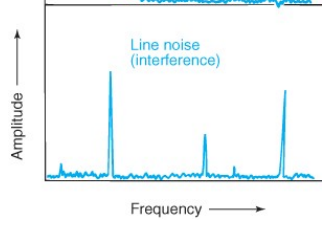achem ch 20 spectrophotometers slides
0.0(0)
Card Sorting
1/49
Earn XP
Description and Tags
Study Analytics
Name | Mastery | Learn | Test | Matching | Spaced |
|---|
No study sessions yet.
50 Terms
1
New cards
single-beam spectrophotometer diagram

2
New cards
single-beam spectrophotometer
• Light from a source is separated into a narrow band of wavelength by a monochromator, passed through the sample in a sample holder, and measured by the detector.
• Using the reference cell containing the solvent or reagent blank, we measure the irradiance P0 striking the detector.
• We replace the blank with the sample and if it absorbs some radiation, we measure the irradiance P striking the detector.
• Using the reference cell containing the solvent or reagent blank, we measure the irradiance P0 striking the detector.
• We replace the blank with the sample and if it absorbs some radiation, we measure the irradiance P striking the detector.
3
New cards
Disadvantages of single-beam instruments
• The sample and the reference must be placed alternately in the beam.
• For measurements at multiple wavelengths, the reference must be run at each wavelength.
• Poor for measuring absorbance versus time for kinetics studies because both the source and the detector response slowly drift.
• For measurements at multiple wavelengths, the reference must be run at each wavelength.
• Poor for measuring absorbance versus time for kinetics studies because both the source and the detector response slowly drift.
4
New cards
double-beam spectrophotometer diagram

5
New cards
double-beam spectrophotometer
• The beam is alternately sent through the reference and sample cells.
• It is chopped several times a second.
• When light passes through the sample, P is measured; through the reference, P0 is measured.
• P is compared to P0, T is obtained and converted to A.
• Measure blank and sample at same time to do kinetics bc over time the sample signal may change, so the blank helps record the changes bc u can compare them at the same time
• It is chopped several times a second.
• When light passes through the sample, P is measured; through the reference, P0 is measured.
• P is compared to P0, T is obtained and converted to A.
• Measure blank and sample at same time to do kinetics bc over time the sample signal may change, so the blank helps record the changes bc u can compare them at the same time

6
New cards
tungsten lamp
an excellent source of continuous visible and near-IR radiation, giving useful radiation in the range 320 to 2500 nm.
7
New cards
deuterium arc lamp
UV usually employs this. emits UV radiation from 110 to 400 nm.
8
New cards
In a UV-Vis instrument…
…a change is made between deuterium and tungsten lamps when passing through 360 nm so that the lamp of highest intensity is always used
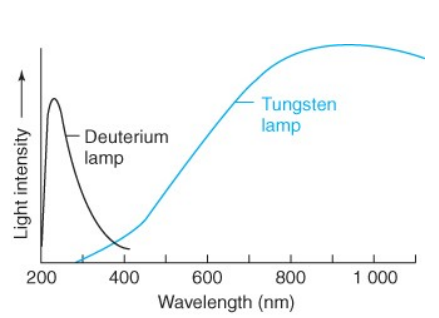
9
New cards
silicon carbide glowbar
Infrared radiation (4 000 to 200 cm- 1) is obtained using this. emits approximately the same spectrum as a blackbody at 1 000 K.
10
New cards
Lasers
give isolated lines of a single wavelength
11
New cards
types of laser light
1. Monochromatic
2. Extremely bright
3. Collimated
4. Polarized
5. Coherent
12
New cards
population inversion
A necessary condition for lasing. a higher energy state has a greater population, n, than a lower energy state in the lasing medium (in the figure, this occurs when the population of E2 exceeds that of E1).
• Molecules in the ground state, E0, of the lasing medium are pumped to excited state E3 by broadband radiation from a powerful lamp or an electric discharge.
• Molecules in E3 rapidly relax to E2, which has a relatively long lifetime.
• After a molecule in E2 decays to E1, it rapidly relaxes to the ground state, E0, thereby keeping the population of E2 greater than the population of E1.
• Pump energy is directed through the side of the lasing medium to create the population inversion.
• One end of the laser cavity is a mirror that reflects all light (0% transmittance). The other end is a partially transparent mirror that reflects most of the light (1% transmittance).
• Photons with energy E2 – E1 that bounce back and forth between the mirrors stimulate an avalanche of new photons.
• The small amount of light passing through the mirror on the right is the useful output of the laser.
• Molecules in the ground state, E0, of the lasing medium are pumped to excited state E3 by broadband radiation from a powerful lamp or an electric discharge.
• Molecules in E3 rapidly relax to E2, which has a relatively long lifetime.
• After a molecule in E2 decays to E1, it rapidly relaxes to the ground state, E0, thereby keeping the population of E2 greater than the population of E1.
• Pump energy is directed through the side of the lasing medium to create the population inversion.
• One end of the laser cavity is a mirror that reflects all light (0% transmittance). The other end is a partially transparent mirror that reflects most of the light (1% transmittance).
• Photons with energy E2 – E1 that bounce back and forth between the mirrors stimulate an avalanche of new photons.
• The small amount of light passing through the mirror on the right is the useful output of the laser.
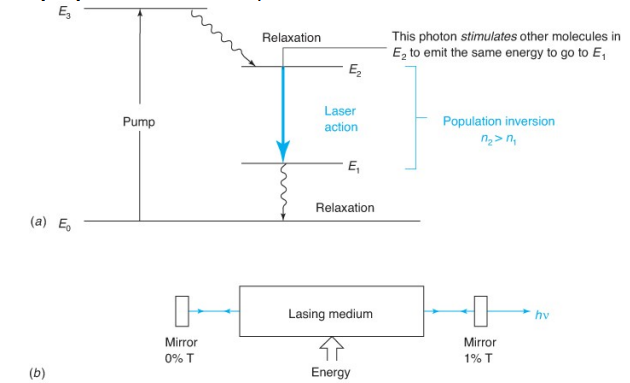
13
New cards
monochromator
disperses light into its component λ ’s and selects a narrow band to pass on to the sample or detector.
14
New cards
grating
has closely ruled lines, each behaving as a separate source of radiation. Different wavelengths of light are diffracted at different angles from this. Rotation allows different wavelengths to reach the sample.
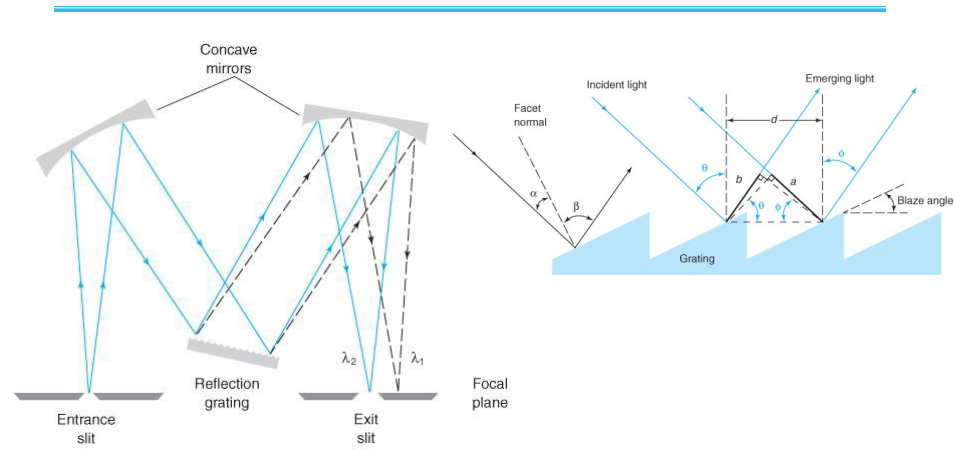
15
New cards
phase
When adjacent light waves are in ______,__ they reinforce each other. When they are not in ____, they partially or completely cancel each other.
16
New cards
Resolution
measures the ability to separate two closely spaced peaks. The greater this is, the smaller the difference (Δλ ) between two wavelengths that can be distinguished from each other
17
New cards
The resolution of a grating is given by the equation
The greater the number of grooves (smaller the spacing), the higher the resolution.
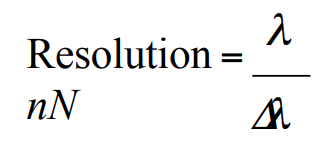
18
New cards
Decreasing the exit slit width
To select a narrower band of λ ’s from the monochromator, we do this. A narrower bandwidth gives better performance. This decreases the selected bandwidth (wavelengths) and decreases the energy to the detector
19
New cards
Relative efficiency
There is a trade-off between resolution and signal. The narrower the exit slit, the greater the ability to resolve closely spaced peaks and the noisier the spectrum.
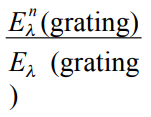
20
New cards
Stray light
λ ’s outside the bandwidth expected from the monochromator reaches the detector from:
1. Unwanted diffraction orders
2. Outside of the instrument when the sample compartment is not perfectly sealed.
Error from this is most serious when sample absorbance is high. Filters are used to permit only certain bands of λ ’s from passing through.
in absorbance stray light will cause negative error because the detector gets more light than it should so the absorbance will be measured lower. In fluorescence the error will be positive because there will be more light measured
1. Unwanted diffraction orders
2. Outside of the instrument when the sample compartment is not perfectly sealed.
Error from this is most serious when sample absorbance is high. Filters are used to permit only certain bands of λ ’s from passing through.
in absorbance stray light will cause negative error because the detector gets more light than it should so the absorbance will be measured lower. In fluorescence the error will be positive because there will be more light measured
21
New cards
detector
produces an electric signal when it is struck by photons. response is a function of of incident light.
22
New cards
Photomultiplier Tube
contains a photoemissive surface (photocathode) as well as several additional surfaces (dynodes) that emit a cascade of electrons when struck by an electron from a photosensitive area.
23
New cards
Photomultiplier Tube theory
• Photon strikes the photosensitive surface and electrons are ejected.
• They are accelerated and strike the dynode with more than their original kinetic energy.
• Each dynode is more positive than the previous.
• Each electron causes emission of several additional electrons.
• 10^6 - 10^7 electrons reach the anode for each incident photon.
• Instruments with photomultiplier tube detectors scan through a spectrum one l at a time.
• They are accelerated and strike the dynode with more than their original kinetic energy.
• Each dynode is more positive than the previous.
• Each electron causes emission of several additional electrons.
• 10^6 - 10^7 electrons reach the anode for each incident photon.
• Instruments with photomultiplier tube detectors scan through a spectrum one l at a time.
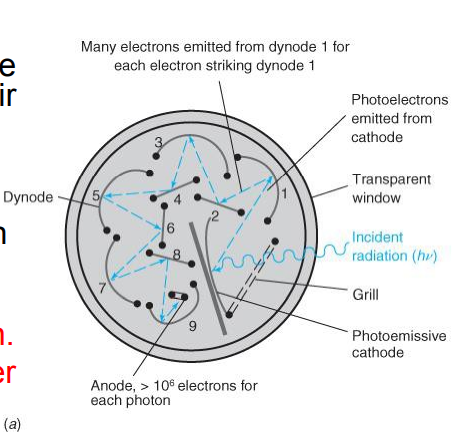
24
New cards
photodiode array
essential for rapid spectroscopy. Rows of p-type silicon on a substrate of n-type silicon create a series of pn junction diodes. Photons absorbed in the semiconductor create mobile electron-hole pairs.
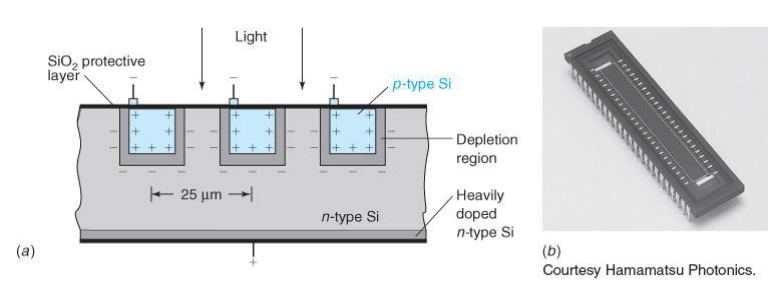
25
New cards
photodiode array spectrophotometer
records the entire spectrum at once in a fraction of a second. White light is passed through the sample, then a polychromator disperses light into its component wavelengths and directs the light at the photodiode array. Each diode receives a different wavelength.

26
New cards
photodiode array spectrophotometer advantages and disadvantages
Advantages:
• Allow faster spectral acquisition (
• Allow faster spectral acquisition (
27
New cards
charge coupled device
an extremely sensitive detector that stores photo-generated charge in a two-dimensional array.
• Constructed of p-doped Si on an n-doped substrate.
• Capped with an insulating layer of SiO2, on top of which is a pattern of conducting Si electrodes.
• Light absorbed in the p-doped region introduces an electron into the conduction band and a hole is left in the valence band.
• The electron is attracted to and stored at the positive electrode.
• The hole migrates to the n-doped substrate.
• Electrodes store 10^5 electrons before they spill out into adjacent elements.
• Electrons stored in each pixel of the top row are moved into the serial register at the top and charge is read.
• The next row moves up and is read until the entire array has been read.
• Charge transfer is efficient – loss of only five of every 10^6 electrons.
• Constructed of p-doped Si on an n-doped substrate.
• Capped with an insulating layer of SiO2, on top of which is a pattern of conducting Si electrodes.
• Light absorbed in the p-doped region introduces an electron into the conduction band and a hole is left in the valence band.
• The electron is attracted to and stored at the positive electrode.
• The hole migrates to the n-doped substrate.
• Electrodes store 10^5 electrons before they spill out into adjacent elements.
• Electrons stored in each pixel of the top row are moved into the serial register at the top and charge is read.
• The next row moves up and is read until the entire array has been read.
• Charge transfer is efficient – loss of only five of every 10^6 electrons.
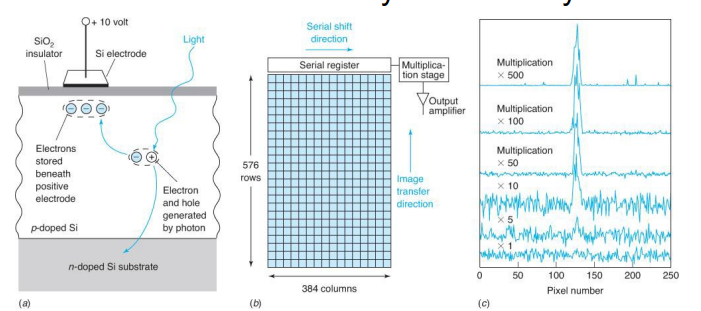
28
New cards
Infrared detectors
Infrared photons are not energetic enough to eject electrons from a photosensitive surface or promote electrons from the valence band of Si to the conduction band.
29
New cards
Thermocouples
junctions of specific alloys that have a predictable and reproducible relationship between temperature and voltage. If one is blackened to absorb radiation, its temperature and therefore voltage becomes sensitive to radiation. convert a temperature gradient into electricity
30
New cards
ferroelectric material
he dipole moments of molecules remain aligned in the absence of an external field. This gives the material a permanent electric polarization. When IR radiation is absorbed, the polarization changes and a voltage develops across the material.
31
New cards
deuterated triglycine sulfate (DTGS)
an example of ferroelectric material. a common detector in Fourier transform spectrometers
32
New cards
Photoconductive detectors
semiconductors that have a small band gap that corresponds to IR energies. When they absorb a photon, an electron is excited into the conduction band and collected at an electrode.
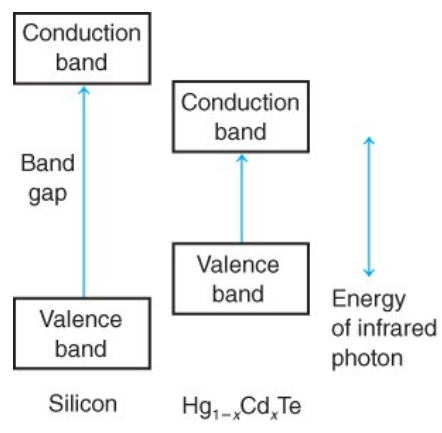
33
New cards
types of Photoconductive detectors
IR – mercury/cadmium telluride (MCT)
NIR – lead sulfide (PbS) and indium antimonide (InSb).
NIR – lead sulfide (PbS) and indium antimonide (InSb).
34
New cards
refracted (bent)
When light passes from one medium into another, its path is _____and is described by Snell’s law:

35
New cards
total internal reflection
Optical fibers carry light by this. The fiber has a high-refractive-index transparent core (n1) enclosed in a lower-refractive index transparent cladding (n2):
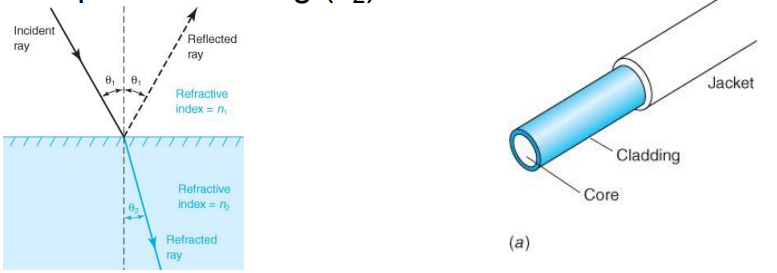
36
New cards
snell’s law when n1 (core) > n2 (cladding)

37
New cards
If n1/n2 >1 …
…there is a range of θi in which essentially all of the light is reflected at the walls of the core and none enters the cladding.

38
New cards
optodes
Optical sensors for specific analytes are made by placing a chemically sensitive layer at the end of a fiber
39
New cards
waveguide
A flat material in which light is totally reflected because n1 (material) > n2 (surroundings)
40
New cards
The light is totally reflected if..

41
New cards
Evanescent wave
the part of the light that penetrates the wall
42
New cards
attenuated total reflectance
The evanescent wave extends into the sorbent beads.
When caffeine is present λ ’s absorbed by caffeine are attenuated. Each peak in the spectrum arises from a vibrational mode of caffeine.
When caffeine is present λ ’s absorbed by caffeine are attenuated. Each peak in the spectrum arises from a vibrational mode of caffeine.
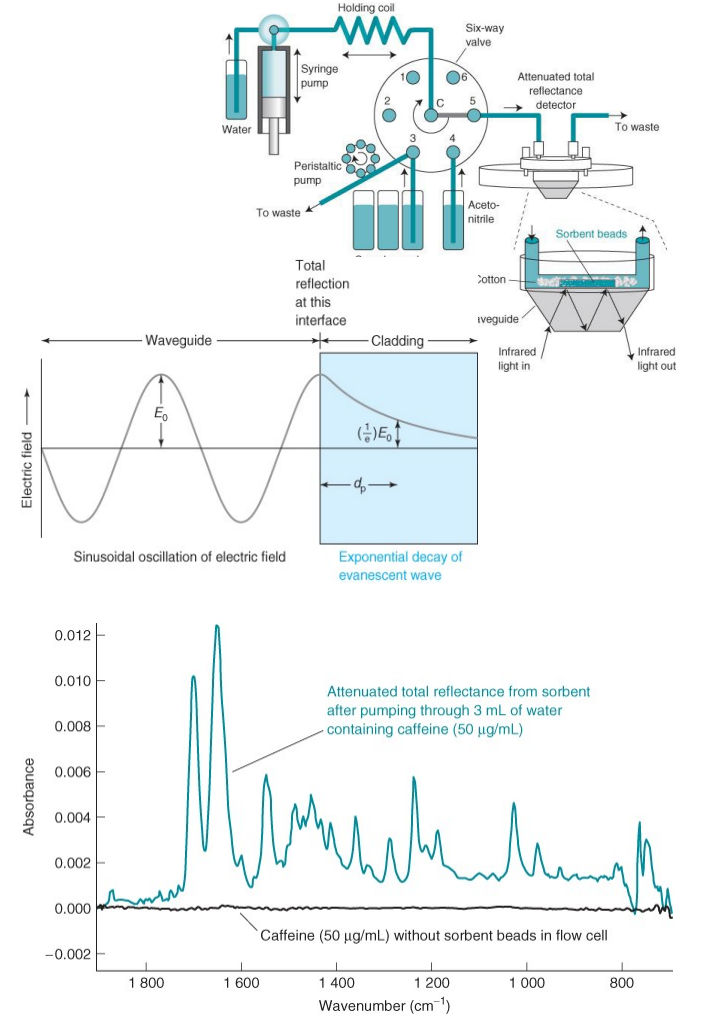
43
New cards
surface plasmon (Asurface plasma wave)
propagates along the boundary between a metal and an insulator (dielectric).
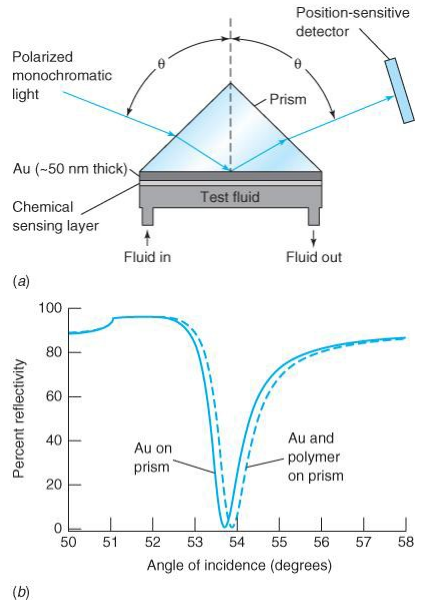
44
New cards
Signal averaging
can improve the quality of data. The signal is measured from the middle of the baseline noise to the middle of the noisy peak.
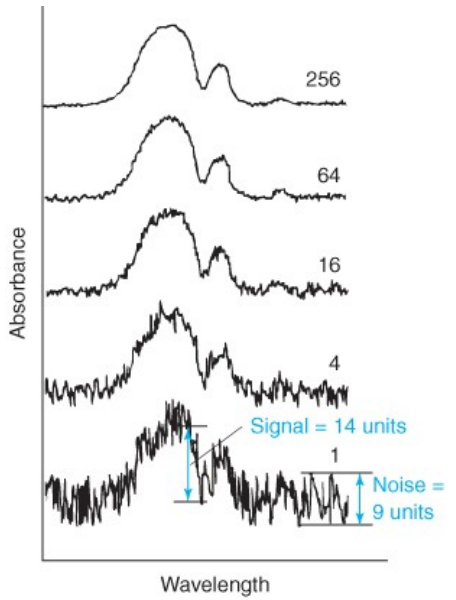
45
New cards
root-mean-square (rms) noise
A more common measurement of noise, which requires a digitized signal and a computer. the noise using this technique is \~5 times less than the peak-to-peak noise.
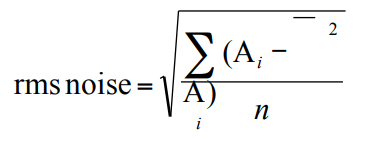
46
New cards
Dealing with Noise
• When the spectrum is recorded twice and the results added, the signal is the same in both spectra and adds to give twice the value of each spectrum.
• Collecting n spectra increases the signal by n times.
• Noise is random, so it may be positive or negative at any point. If n spectra are recorded, the noise increases in proportion to the square root of n.
• The signal-to-noise ratio therefore increases by (img)
• So, in order to increase the signal-to-noise ratio by a factor of 10, we must average 100 spectra.
• Collecting n spectra increases the signal by n times.
• Noise is random, so it may be positive or negative at any point. If n spectra are recorded, the noise increases in proportion to the square root of n.
• The signal-to-noise ratio therefore increases by (img)
• So, in order to increase the signal-to-noise ratio by a factor of 10, we must average 100 spectra.
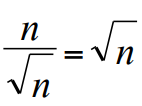
47
New cards
Types of noise
white noise, 1/f noise, line noise
48
New cards
White noise
normal, random, Gaussian noise arises from causes such as random motions of electrons within a circuit.
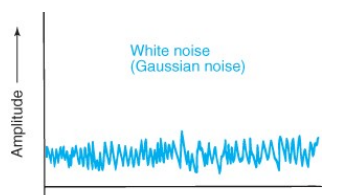
49
New cards
1/f noise
also called drift, greatest at zero frequency and decreases in proportion to 1/ frequency
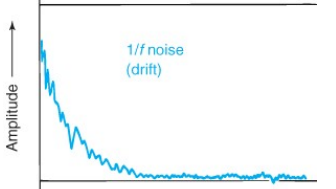
50
New cards
Line noise
also called interference or whistle noise, at discrete frequencies such as the 60-Hz transmission-line frequency
